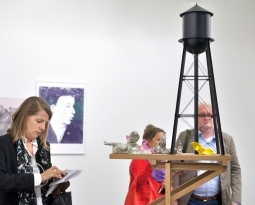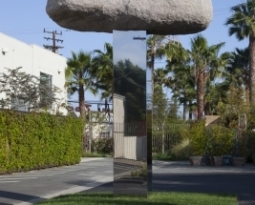Graham Nickson: Paintings 1972 – 2011, Paths of the Sun
Knoedler & Company
September 15 – October 29, 2011
In viewing Graham Nickson’s recent survey exhibition of landscape paintings, it occurred to me that the word transcendence is still useful in describing the manner in which color permeates the surface and transforms our notion of the open sky. While the history of landscape painting, going back to the Netherlandish Van Ruisdael in the late seventeenth century, gave much attention to the expressive content of the sky, not all landscapes offer this point of view. The sky becomes visible again in the paintings of Turner, and later, more exuberantly in the work of Die Brücke painters, such as Erich Heckel and Karl Schmidt-Rottluff, but generally the metaphor of nature’s canvas tends less toward description than becoming an internalized state of mind, an envisioning based on a sustained period of viewing in which time becomes ineffable. The connectivity between the sky and the horizon persuaded me to discern my reflectivity as a distillation of form. Here the eyes truly become, as Huxley once remarked, “the windows to the brain.”
To transcend the everyday realities of urban life is a kind of exhilaration that suggests there is more to the act of painting than a text and more to aesthetics than a graduate course. In this instance, I refer to paintings that incite the need to move beyond the obvious into a deeper subjectivity, one that is less hinged on an assumed protocol of viewing than on how one feels the intelligence of painting. This became precisely evident as I observed the large painting, Traveler: Red Sky (2002), and again in a watercolor, Sarageto Dawn XXIV (2006). In each case, the blazing color emerges into light on the surface with a restrained exuberance that moves beyond textual formalities, finally to evoke a rarified experience that is both sensory and cognitive.
Having previously written about the work from the 1970s, of which a selection is included in this exhibition, I was alerted to the sensitivity of perception in small-scale oils, such as Roman Landscape, Blue Cloud, Zigzag Balustrade (1973-74) and Roman Sunset: First Series (1973), painted during the artist’s Roman sojourn upon receiving the Prix.
After the redolent intimacy contained in the early paintings, the exhibition moves us to the larger landscapes of the 1990s and twenty-first century, including a surprise series of watercolors, spanning the two decades, collectively titled Monumental Tree Series (1999–2000). Here the magnitude of expressivity opens new potential, suggesting ways of seeing and interpreting through color that touch on the tree paintings of Mondrian from his early breakthrough period from 1911–12. In reading critic Lilly Wei’s analysis of these works in her illuminating catalog essay, one might further consider the extent to which these watercolors express transcendence as a rejuvenated method of seeing that Nickson has subliminally brought into this genre.
I would put it in the following way. Graham Nickson is keenly aware of what he does and how he does it. He has achieved a master status in terms of the landscapes, which are generally more open than his large-scale figurative paintings, which suggest another, more symbolic direction in his work. By openness, I equate this notion with a transcendent aptitude given to the colorful skies made evident in the Knoedler exhibition. Here the artist clearly intends to suspend the limits of temporality and thereby hold the trace of nature’s temporality. This generally happens during the early hours of the day when the artist harnesses the light as it rises into view. Temporality is also timeless in nature, and it is precisely this paradox that awakens the senses. Nickson has masterfully taken control of this phenomenon and, in doing so, has opened our threshold of seeing. Here the ordinary appears uplifting. It is a kind of gift the artist reveals as he struggles to get within the persistence of time. One might consider these paintings from the perspective of the poet Yeats who understood the true work of art as a secret hearth within the wilds of nature where intelligence finds its origins.
http://whitehotmagazine.com/articles/2011-graham-nickson-knoedler-company/2382





